Is Retail Out Of The Woods?
By Keith Jelinek, Rick Maicki, Rich Vitaro, and Christopher Ventry, Berkeley Research Group
In 2017, the U.S. retail industry experienced unprecedented turbulence and many in the industry see more challenges to come in 2018. The impact of Amazon and other online retailers has disrupted how retailers do business and reach consumers. Store closings have reached record levels. Numerous large, well-known retail companies have filed for bankruptcy, restructured, and in many cases closed down their businesses. The continuing evolution of shoppers creates new demands on retailers that impact all aspects of the business, from stores to backstage operations to information technology and supply chain capabilities — including home delivery. The disruption continues to drive concern with investors, creditors, industry analysts, and — most of all — companies themselves.
Retail 2017: The Good, The Bad, & The Ugly
The Good
Total sales for the year increased 4.3 percent over 2016, the best year-over-year increase since 2011. Going into the holidays, most industry analysts expected holiday sales to increase about 4 to 4.5 percent, but were pleasantly surprised to see an increase of about 6 percent. Online and mobile sales continued to grab headlines, as consumers
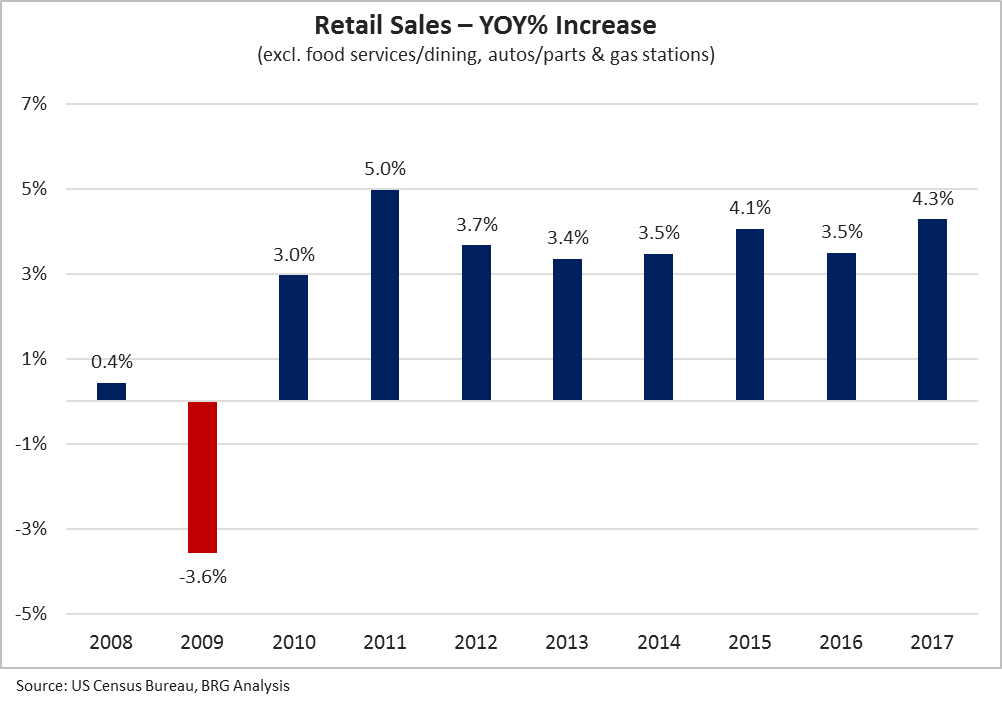
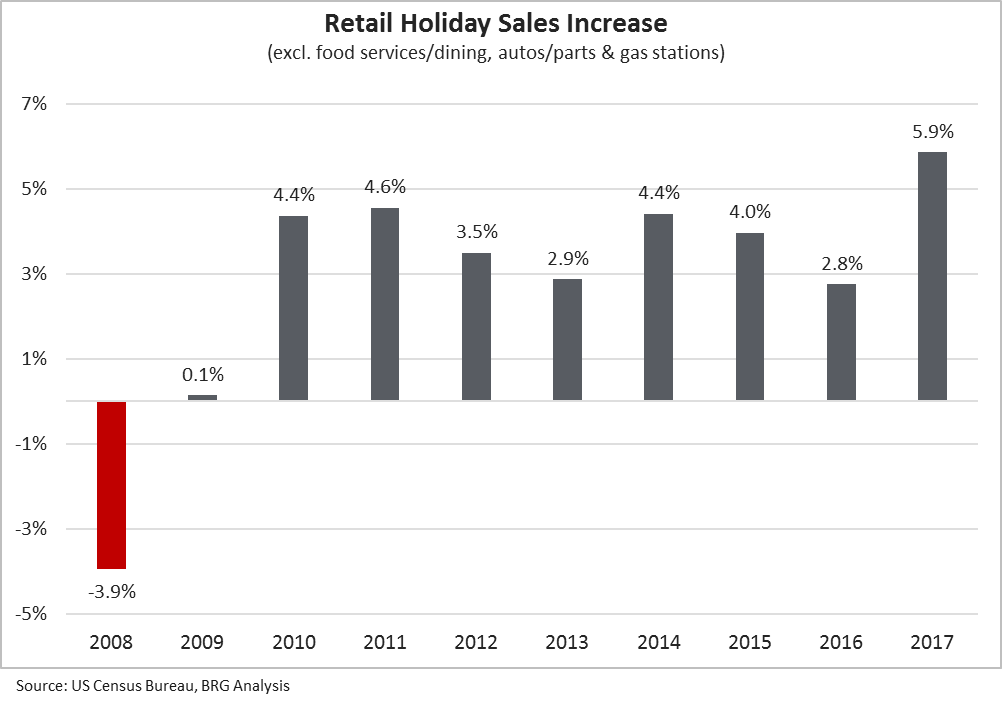
continued to rely on technology to shop. And while online and mobile commerce continued to demand attention from all corners of retail, the spike in holiday sales was attributable more to a bump seen for in-store sales, demonstrating to anyone paying attention that stores are not dead. The role of physical stores is certainly changing but consumers are not shopping 100 percent online quite yet.
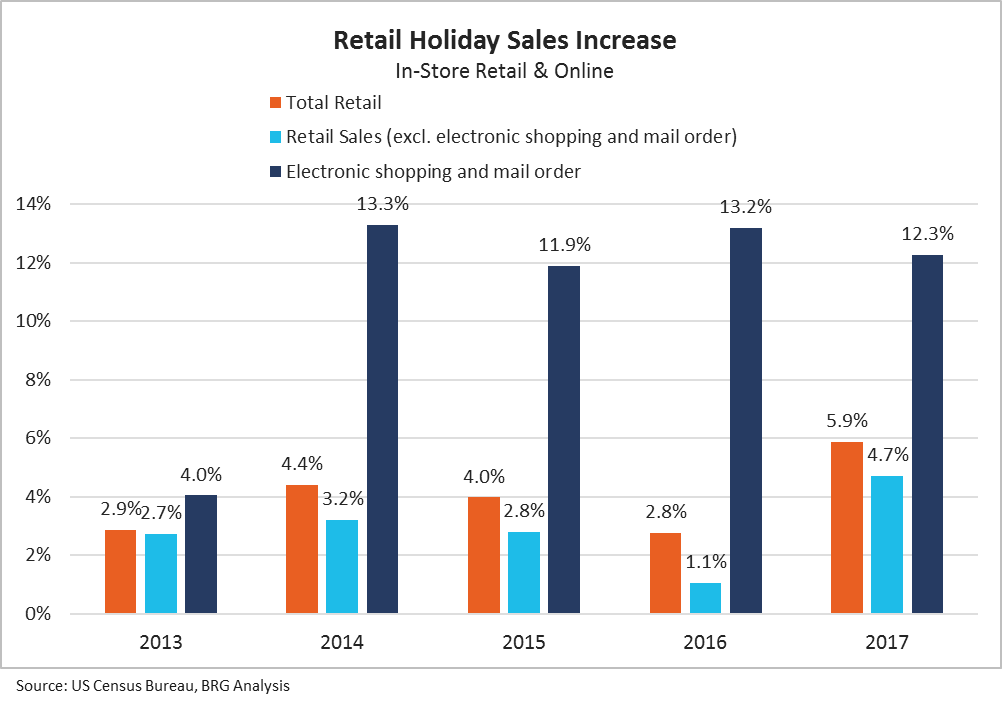 The importance of stores in driving the bump in holiday sales can be seen by breaking down the holiday sales increases over the last five years. Based on U.S. Census Bureau sales reports, electronic and mail order shopping has increased on average about 13 percent per year since 2014. In-store sales had shown increases of just about 2.5 percent over the same period, but in 2017 the increase was 4.7 percent. This unexpected jump drove the total year-over-year (YOY) holiday sales increase to unexpected levels.
The importance of stores in driving the bump in holiday sales can be seen by breaking down the holiday sales increases over the last five years. Based on U.S. Census Bureau sales reports, electronic and mail order shopping has increased on average about 13 percent per year since 2014. In-store sales had shown increases of just about 2.5 percent over the same period, but in 2017 the increase was 4.7 percent. This unexpected jump drove the total year-over-year (YOY) holiday sales increase to unexpected levels.
Still, even with good YOY sales increases, the caution for retailers is the hit to gross margins. What was the bottom-line cost of promotional activity in the fourth quarter of 2017? What was the additional expense — especially shipping costs — to retailers in executing online transactions? Will troubled retailers reverse course and execute strategies that enable them to compete profitably with the continuing competitive pressures that will only get more challenging as we move through 2018?
The Bad And The Ugly
YOY sales increases were mediocre in a number of retail channels and the influence of online continues to build. Amazon is taking aim at new retail segments, like pet supplies, or looking to strengthen where their impact is not yet significant, like grocery. Evolving demographics have created a moving target that many retailers have yet to understand or successfully attract. Examination of full-year sales changes shows there are retail segments still “on the bubble” for 2018. Specialty apparel, footwear, department stores, consumer electronics, and sporting goods were segments that saw sales increases in-store that were below the overall retail average in 2017.
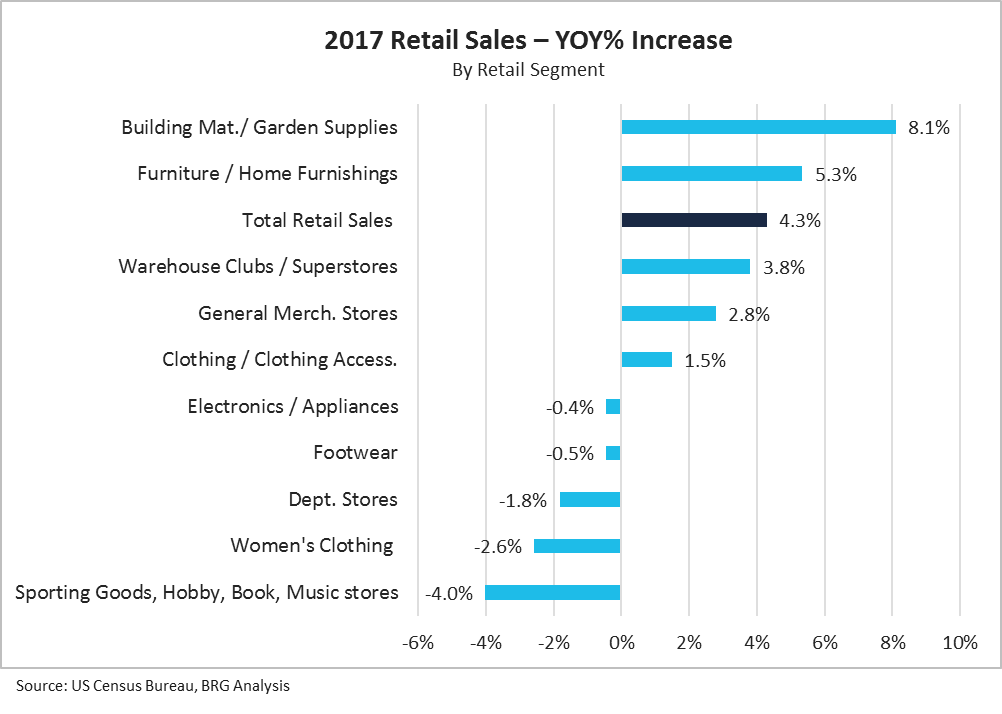 For many companies, the last 12 to 18 months meant more than just mediocre sales increases. Many retailers dealt with the challenge of restructuring and often, Chapter 11. Store closures reached record numbers in 2017, with over 7,000 stores closing their doors.
For many companies, the last 12 to 18 months meant more than just mediocre sales increases. Many retailers dealt with the challenge of restructuring and often, Chapter 11. Store closures reached record numbers in 2017, with over 7,000 stores closing their doors.
Among the “big name” retailers filing Chapter 11 bankruptcy, many closed all their stores and ceased operations completely. The list of bankruptcy filings includes retailers from multiple segments, with specialty apparel suffering the most serious blows as those stores were hit by intense competition and reduced mall traffic. The retailers filing for Chapter 11 (some for the second time) included The Limited, Wet Seal, Gymboree, BCBG Max Azria, True Religion, rue21, Aerosoles, Payless ShoeSource, Gordman’s, Toys ‘R’ Us, Radio Shack, hhgregg, Gander Mountain, Vitamin World, and Perfumania. Some of these companies emerged from Chapter 11, or are working toward that end. Many, like Gordman’s, Gander Mountain, and hhgregg simply vanished from the retail landscape.
Retailers are anxious to move past 2017, but there are valuable lessons to be learned from the last 12 to 18 months of retail distress. In late 2017, BRG professionals surveyed over 100 retail executives for their perspective on challenges in retail and their outlook for 2018. When asked about the biggest issues and impacts in retail in 2017, 90 percent of respondents said the competitive impact of the internet was “Extremely” or “Very Impactful” to the retail industry in 2017; 80 percent cited evolving consumer demographics as extremely or very impactful, and over 75 percent pointed out the impact of reduced store traffic. Clearly, retail executives agree the biggest impacts in retail are evolving consumer demographics and the need to provide an integrated shopping experience across all points of contact with shoppers. The big question: What will retailers do about it?
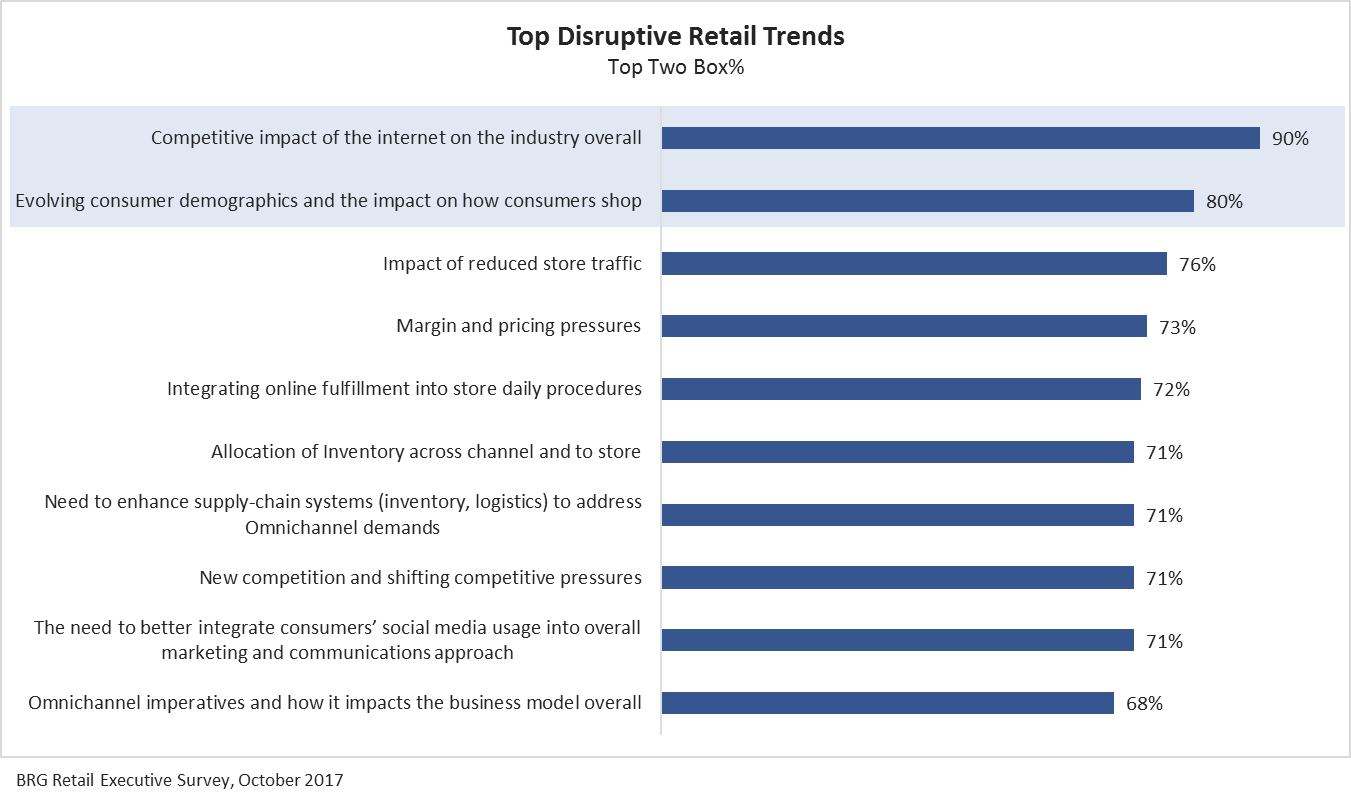
Outlook For 2018
In our executive survey, we inquired about expectations for 2018, specifically asking whether the turmoil seen in retail was the beginning of a prolonged challenge that would last into 2018 or if the environment would calm down. Nearly 60 percent expected the situation to worsen, while just 14 percent expected improvement.
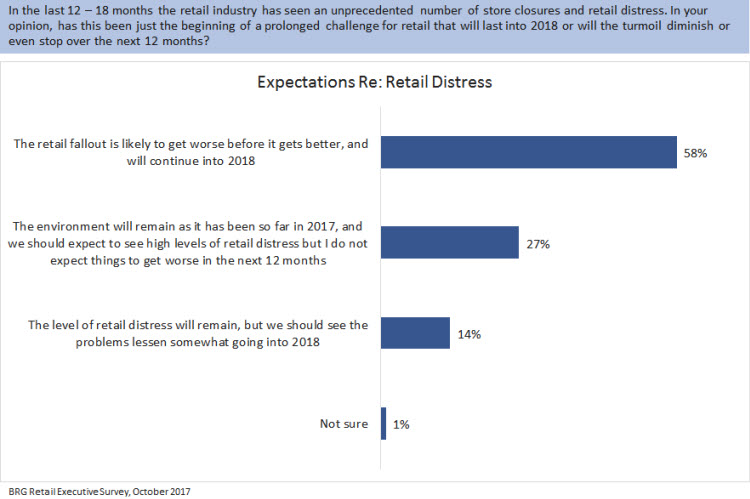
In addition, we saw agreement among executives on key strategic initiatives for 2018. Not surprisingly, the main focus will be on creating omni-channel capabilities that allow companies to connect with today’s technologically sophisticated consumer, and to do so profitably in the face of stiff competitive pressures from Amazon and a range of traditional retailers that sell goods across multiple retail categories (mass, clubs, discount stores, subscriptions, etc.).
The priorities for 2018 information technology spend also reflect the laser focus of retailers on the dynamics of the
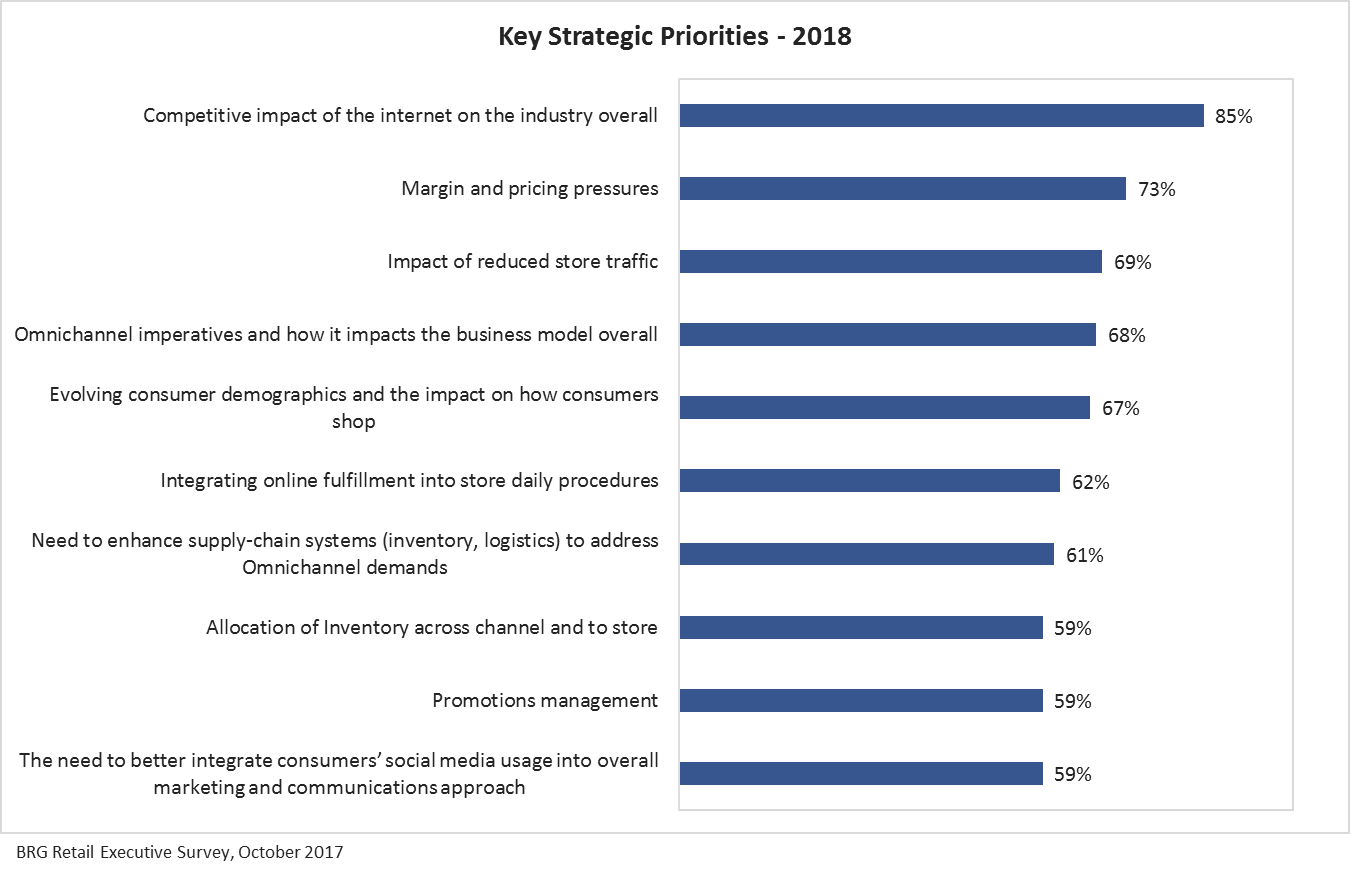
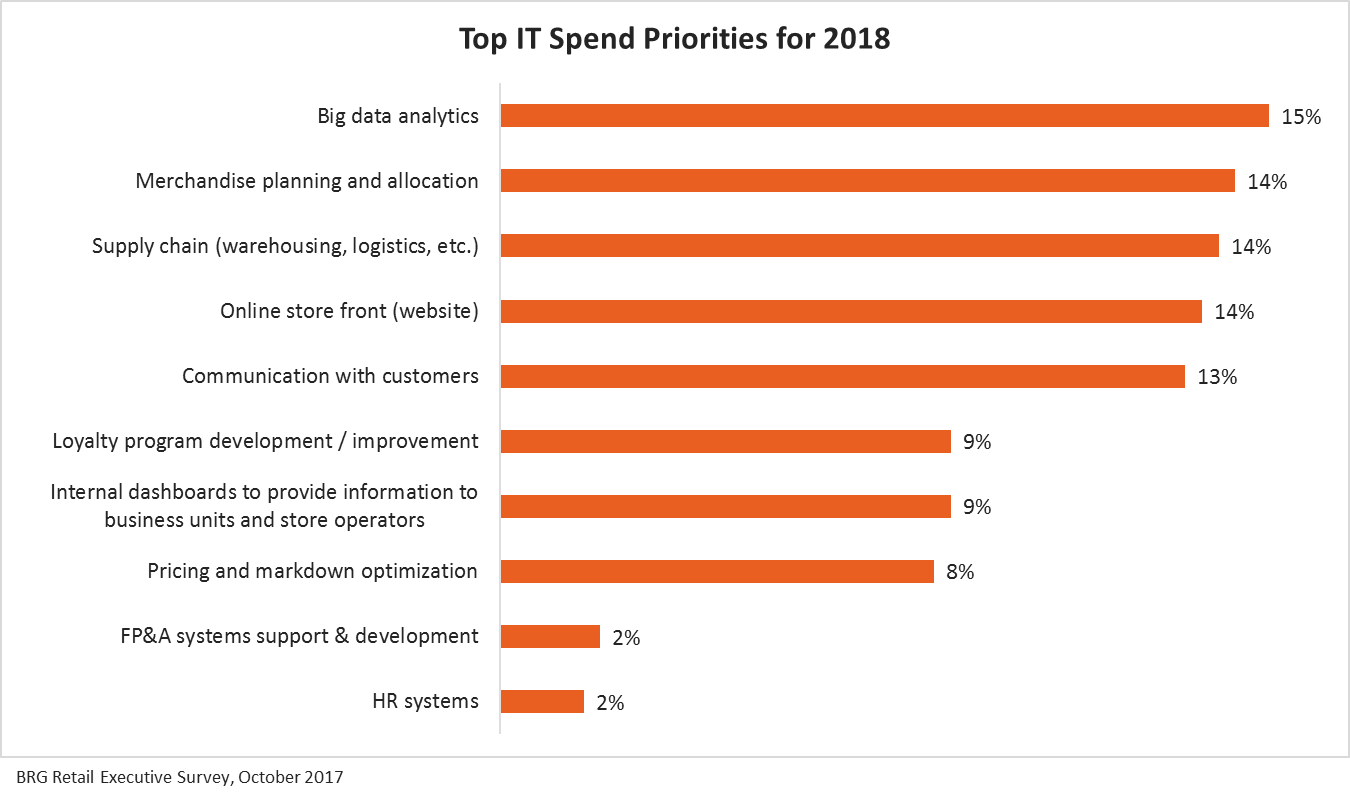
current business environment. Top IT spend initiatives included Big Data analytics, merchandise planning, supply chain, the online store front, and communication with customers. Our observation is retailers get it; the question is whether they have the organizational resolve and financial capabilities to get it done.
Key Challenges & Opportunities For 2018
The retail industry has experienced unprecedented turmoil, and many of those still in business are in a precarious state. The overall economic environment remains favorable to continued consumer confidence (and spending), but the ongoing influence and change resulting from the evolving preferences of the millennial consumer demand adaptation. Based on the feedback we received from retail executives and from our work with clients across a range of retail segments, we see the following as table stakes for retail survival and success in 2018 and beyond:
- Integration of Online & Stores: Develop omni-channel success through web/mobile/store integration; use technology to enhance the in-store shopping process; be competitive on basic omni-channel requirements such as buy online, ship to home, in-store pickup and returns, and inventory visibility; drive consistency in pricing and promotions across all consumer touchpoints.
- Personalization of Customer Experience: Understand how shoppers interact with your brand (i.e., the customer “journey”); make the marketing investment to reignite loyalty programs, bolster marketing communications, and improve consumer segmentation; create the omni-channel experience younger shoppers crave.
- Ability to Capture and Use Customer Data Points: A retailer’s shoppers (and those who do not shop at that retailer) continuously provide key data points that can lead to “winning formula” for retailers, if compiled and analyzed. For example, historical purchase and return data can help define honed assortments, size-curve adjustments, trend identification, inventory allocation and replenishment shifts, price-point precision, etc.
- Rationalization of the Store Portfolio: Consider the complex dynamics of the current store portfolio; understand the role of physical stores in the customer journey; develop and implement a detailed plan to achieve the optimal structure.
- Investment in IT and Systems to Support Business Strategies: Invest in advanced analytics to understand the interaction of online and in-store touchpoints; integrate logistics and inventory across the supply chain and distribution network; apply current technologies to bring marketing and social media together to reinvigorate loyalty programs.
- Judicious Management of Working Capital: Develop capital plan that recognizes business trends; manage capital structure as part of strategic plan
The traditional retail business model as we have known it is dead. The new model for success is being crafted every day and while retail is not going away, it is in a state of significant revolution. As we noted in January 2018: “There is a good survival opportunity for incumbents whose leaders can solve the puzzle. Stronger operating capabilities can support the company as it exercises dynamic capabilities that allow it to create the new business model(s) and channels needed for long-term evolutionary fitness.”
The views and opinions expressed in this article are those of the authors and do not necessarily reflect the opinions, position, or policy of Berkeley Research Group, LLC or its other employees and affiliates.
